Du lundi au samedi : de 9h00 à 19h00 Le dimanche est FERMÉ
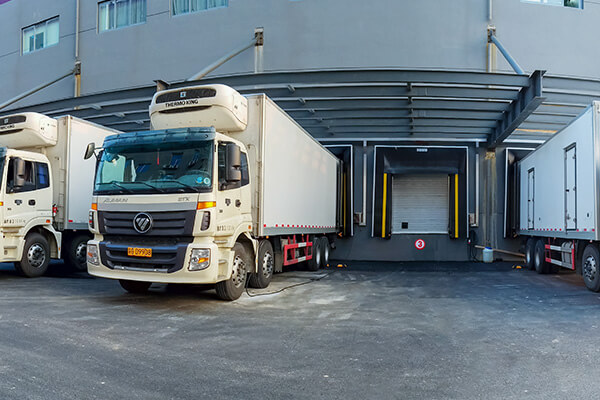
When it comes to the efficiency and safety of loading and unloading goods, the design of loading docks is crucial. The market offers various types of loading docks, each tailored to specific needs and environments. Understanding the functions and applications of different loading dock types can help save time, reduce costs, and improve operational workflows. Whether for warehouse loading docks, logistics, or distribution center loading docks. This guide explores different types of loading docks and their unique features, as well as how businesses can identify the loading dock solution that best fits their needs. Whether you are optimizing a warehouse, managing a logistics hub, or overseeing a distribution center. This article provides the insights needed to make informed decisions about loading dock solutions.
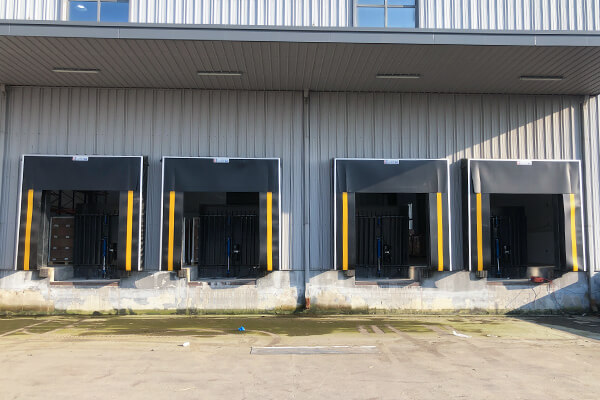
Contents
- 1 What Are Loading Docks?
- 2 Common Types of Loading Docks
- 3 Essential Components of Loading Bay Equipment
- 4 Loading Dock Design Considerations
- 5 Conclusion
- 6 FAQs
- 6.1 What are the different types of loading docks available?
- 6.2 How does a well-designed loading dock improve warehouse efficiency?
- 6.3 What is the significance of dock lights in a loading bay?
- 6.4 What factors should I consider when choosing the right dock type?
- 6.5 Can you explain the concept of flush loading docks?
- 6.6 What are dock levelers and why are they important?
- 6.7 How do enclosed loading docks differ from open loading docks?
- 6.8 What is the role of a sawtooth loading dock in a warehouse layout?
- 7 References:
What Are Loading Docks?
Definition and Importance of Loading Docks
Loading docks serve as the pivotal interface between transportation and warehousing within modern logistics. At their core, loading docks are specially designed platforms or bays where goods are transferred between trucks, containers, railcars, or other vehicles, and a facility’s storage or production area. Their fundamental importance in supply chain operations stems from their role as gateways for incoming and outgoing freight, impacting everything from product flow to overall throughput.
Impact on Warehouse Operations
The operational efficiency and safety of loading docks directly impact operational costs and risk management. Especially for warehouse loading docks, logistics, and distribution center loading docks. A well-designed loading dock simplifies loading and unloading processes, minimizes bottlenecks, and reduces the risk of workplace injuries. Key components like loading dock levelers, sealing strips, dock shelters, and advanced loading dock safety systems enhance workflow smoothness while protecting the safety of personnel and products.
Choosing the right type of loading dock has a lasting impact on daily operations and long-term return on investment. A reasonable loading dock design optimizes truck turnaround time, adapts to changing business needs. And ultimately improves the efficiency and profitability of the entire supply chain—making it a critical decision for businesses looking to streamline logistics and cut unnecessary costs.
Common Types of Loading Docks
Flush Loading Docks

The operational efficiency and safety of loading docks directly impact operational costs and risk management. Especially for warehouse loading docks, logistics hub loading docks, and distribution center loading docks. A well-designed loading dock simplifies loading and unloading processes, minimizes bottlenecks, and reduces the risk of workplace injuries. Key components like loading dock levelers, sealing strips, dock shelters, and advanced loading dock safety systems enhance workflow smoothness while protecting the safety of personnel and products.
Choosing the right type of loading dock has a lasting impact on daily operations and long-term return on investment. A reasonable loading dock design optimizes truck turnaround time, adapts to changing business needs, and ultimately improves the efficiency and profitability of the entire supply chain—making it a critical decision for businesses looking to streamline logistics and cut unnecessary costs.
Enclosed Loading Docks
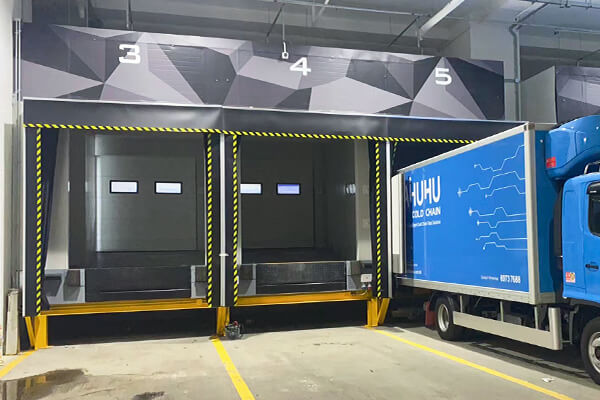
Enclosed loading docks provide a fully sealed space for transferring goods between trucks and facilities, minimizing external factor impacts. They maintain a controlled environment, significantly reducing weather-related risks of contamination, theft, or damage. And it helps businesses gain improved workflow efficiency, enhanced safety, and compliance with regulatory standards. Especially in temperature-sensitive or clean room settings.
Typically used for scenarios requiring product protection, climate control, safety, and overhead lifting capabilities, sparcel handlers often adopt enclosed docks with box truck fleets to boost efficiency and comfort while lowering theft risks. The design also accommodates overhead cranes for efficient flatbed truck loading/unloading, and can be fitted with overhead dock lighting.
Open Loading Docks
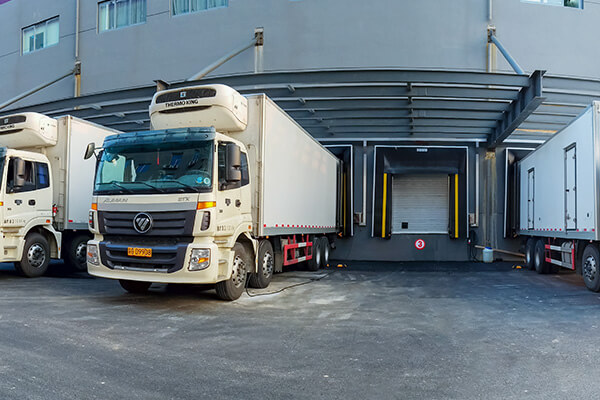
Open loading docks are valued for their flexibility and reduced construction costs. Industries like retail logistics and manufacturing often prefer these designs for their ease of access and ability to accommodate larger vehicles and varied shipment sizes. Businesses leveraging these innovations can position themselves to handle diverse shipments more effectively, even in challenging conditions.
Sawtooth Loading Docks
Sawtooth loading docks are uniquely designed to optimize the movement of vehicles in tight or constrained spaces. These docks are arranged at an angle, resembling the teeth of a saw, which allows trucks to back into the dock with more ease and efficiency. This layout not only reduces the turning radius required for vehicles but also maximizes the available space, making it ideal for facilities located in urban areas or other space-restricted environments. By streamlining loading and unloading operations, sawtooth docks enhance productivity while minimizing delays caused by vehicle maneuvering challenges.
Essential Components of Loading Bay Equipment
Dock Levelers
Dock levelers are essential components of a loading dock, designed to bridge the gap between the dock edge and the trailer bed. They ensure the smooth and safe transfer of goods, accommodating varying trailer heights and dock positions. An effective dock leveler enhances efficiency and minimizes the risk of accidents during loading and unloading operations.
Here are five types of dock levelers:
- Mechanical Dock Levelers
These are operated manually using a spring-loaded mechanism. They are reliable, cost-effective, and simple to maintain, making them ideal for facilities with low-volume operations. - Hydraulic Dock Levelers
Powered by a hydraulic system, these levelers offer a higher level of efficiency and safety. They are easy to operate with the push of a button and can handle heavy-duty applications. - Air-Powered Dock Levelers
Utilizing an inflatable airbag system, these levelers provide smooth operation and are easy to maintain. Their design reduces the risk of hydraulic leaks and is ideal for medium to high-volume loading docks. - Edge-of-Dock Levelers (EOD)
Mounted at the dock edge, EOD levelers are compact and economical options for lighter loads. They offer sufficient height adjustment for most standard trailers. - Vertical Dock Levelers
These are mounted vertically and stored upright when not in use, ensuring a tight seal on the dock for better temperature control. They are commonly used in facilities handling refrigerated goods.
Each type of dock leveler is designed to serve specific operational needs, ensuring safety, functionality, and reliability.
Vehicle Restraint Systems
Vehicle restraint systems are critical for ensuring safety during loading processes and preventing accidents. Especially for loading dock vehicle restraint systems used in warehouse loading docks, logistics, and distribution center loading docks. These systems secure trucks and trailers to the loading dock, minimizing the risk of movement or separation that could endanger worker safety or damage cargo.
Types of Vehicle Restraint Systems
Rotating Hook Restraints
These restraints use a rotating steel hook to lock onto the trailer’s rear impact guard (RIG). They are highly effective for securing trailers and are commonly used due to their reliability in preventing trailer creep or early departure.
Wheel Chock Systems
Wheel chocks are manually placed behind trailer wheels to prevent movement. While cost-effective, they require proper positioning for effective operation and are less secure compared to other mechanical restraints.
Integrated Truck Restraint Systems
Modern vehicle restraint systems often integrate with dock levelers and door controls, providing automated control and visual indicators to operators. This integration enhances efficiency and reduces the risk of human error.
Dock Seals and Shelters
Dock seals and shelters play a critical role in maintaining energy efficiency, protecting goods, and ensuring worker comfort during loading and unloading operations. Loading dock seals typically consist of foam pads that compress against the back of a truck, creating a tight seal to block outside elements like rain, snow, and wind.
Types of Loading Dock Seals and Shelters
- Mechanical Dock Seal
- Abri de quai en éponge
- Abri de quai gonflable
Investing in advanced dock seals and shelters reduces overall operational costs and supports sustainability efforts by conserving energy resources.
List of Loading Dock Design
| Component Name | Description & Function |
|---|---|
| Loading Dock Levelers | Bridge the gap and compensate for height differences between the loading dock floor and truck trailer bed, ensuring smooth and safe transition for material handling equipment. |
| Dock Seals Protection | Flexible foam pads that compress against the truck trailer to create a tight seal around the door opening, preventing energy loss and protecting goods from weather elements. |
| Dock Bumpers Protection | Heavy-duty rubber or steel cushions mounted on the dock face that absorb impact when trucks back up to the loading dock, protecting both the building and vehicle from damage. |
| Dock Lights Safety | High-intensity LED lighting systems that illuminate the interior of truck trailers and dock areas, ensuring safe loading and unloading operations in low-light conditions. |
| Vehicle Restraints Safety | Mechanical or hydraulic systems that secure trucks to the loading dock by engaging the trailer’s rear impact guard, preventing accidental vehicle movement during loading operations. |
| Dock Boards Mechanical | Portable aluminum or steel plates that can be manually positioned to bridge gaps between dock and trailer when permanent dock levelers are not available or suitable. |
| Dock Shelters Protection | Rigid frame structures with flexible curtains that create an enclosed seal around the truck trailer, providing superior weather protection and energy efficiency compared to dock seals. |
| Overhead Doors Structural | Large sectional or sectional overhead doors that provide access to the loading dock area, designed to withstand frequent use and provide security when the dock is not in operation. |
| Safety Barriers Safety | Physical barriers including guardrails, bollards, and safety gates that protect personnel and equipment from falling off the dock edge or being struck by moving vehicles. |
| Communication Systems Communication | Intercom systems, signal lights, and digital displays that facilitate communication between dock workers and truck drivers to coordinate safe and efficient loading operations. |
| Dock Controls Mechanical | Electronic control panels that operate dock levelers, lights, and other automated equipment, often featuring push-button or remote control operation for enhanced convenience and safety. |
| Weather Stripping Protection | Flexible sealing materials installed around dock doors and openings to minimize air infiltration, reduce energy costs, and maintain temperature control in climate-controlled facilities. |
| Approach Ramps Structural | Concrete or steel ramps that provide a smooth transition from ground level to dock height, allowing trucks to easily access elevated loading docks safely and efficiently. |
| Dock Mirrors Safety | Convex safety mirrors strategically positioned to provide truck drivers and dock workers with better visibility of blind spots around the loading dock area during backing and maneuvering operations. |
| Power Supply Units Structural | Electrical power distribution systems that provide electricity to dock equipment, trailer refrigeration units, and material handling equipment operating at the loading dock. |
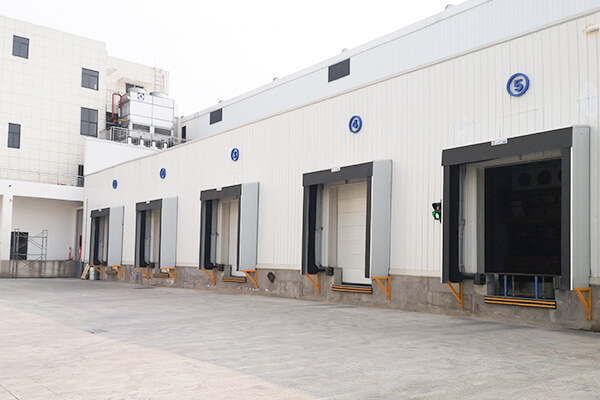
Loading Dock Design Considerations
Space Availability and Facility Layout
The physical space you have available is the first and most important factor in loading dock design. Your facility’s layout dictates the flow of traffic, the type of equipment you can use, and the overall efficiency of your operations. A poorly planned layout can lead to bottlenecks, accidents, and costly delays.
Traffic Flow and Maneuvering Area
Before anything else, consider how trucks will approach, dock, and depart from your facility. You need to provide an adequate apron space—the area directly in front of the dock—for trucks to maneuver safely and efficiently. A crowded or poorly designed apron can cause accidents and slow down the entire loading and unloading process. Plan for clear, designated pathways for both vehicles and pedestrians to prevent collisions.
Dock Configuration and Equipment
Your facility’s internal layout will influence the type of dock you can build. For instance, a flush dock, which is the most common type, sits flat against the building wall. However, if space is limited, an enclosed dock might be more suitable, though it requires more initial investment. The layout also impacts what equipment you can install. Key components like dock levelers, which bridge the gap between the truck and the dock floor, are essential for smooth forklift access. Ensuring you have enough space for the correct installation and operation of these systems is crucial.
Workflow and Safety
A well-designed layout supports a logical workflow, from the moment a truck arrives to when goods are stored in the warehouse. Staging areas near the dock should be large enough to hold incoming and outgoing products without obstructing movement. Incorporating safety features like vehicle restraints, which lock a trailer to the dock, and communication lights, which signal when it’s safe to enter a trailer, are non-negotiable elements for preventing accidents.
Climate and Environmental Factors
Your local climate has a significant impact on loading dock design, influencing everything from energy costs to employee comfort and product integrity. Ignoring environmental factors can lead to high utility bills, damaged goods, and unsafe working conditions.
Energy Efficiency with Seals and Shelters
One of the biggest challenges at a loading dock is maintaining a consistent internal temperature. An open dock door is a massive source of energy loss. Dock seals and shelters are designed to solve this problem. Dock seals are foam pads that a trailer compresses into upon docking, creating an airtight barrier. They are ideal for facilities that service a standard fleet of trucks.
Dock shelters, on the other hand, create a larger, covered enclosure around the top and sides of the trailer. They are more versatile for accommodating various truck sizes and provide excellent protection from rain, snow, and wind. Investing in high-quality seals or shelters can dramatically reduce your heating and cooling costs, protect goods from the elements, and create a more comfortable environment for your staff.
Protecting Your Building and Vehicles
Climate also affects the durability of your infrastructure. Constant exposure to rain, snow, or extreme heat can wear down your building and equipment. Dock bumpers are essential for protecting both your facility wall and the back of the trailer from impact damage during docking. These simple but vital components absorb the force of a truck backing in, preventing costly structural repairs over time. Choosing durable, weather-resistant materials for bumpers, doors, and other external components will ensure they last longer and require less maintenance.
Employee Safety and Comfort
Extreme weather conditions can create hazardous surfaces. Rain or melting snow can make dock levelers slippery, increasing the risk of falls for workers and forklifts. A well-designed dock with a proper shelter keeps the loading area dry and safe. Furthermore, protecting your employees from harsh winds, cold, or heat improves morale and productivity. A comfortable worker is a more focused and efficient worker.
Budget and Long-Term Maintenance
hile it can be tempting to choose the cheapest options upfront, your budget should account for both the initial investment and the total cost of ownership over time. Investing in quality equipment from the start often proves more cost-effective in the long run by reducing maintenance needs, minimizing downtime, and enhancing safety.
Initial Investment vs. Total Cost of Ownership
When it comes to loading dock equipment, low-cost options may save money initially but often lead to higher expenses over time— a key consideration for warehouse loading docks, logistics hub loading docks, and distribution center loading docks. For example, basic mechanical loading dock levelers are cheaper than hydraulic dock levelers upfront, but hydraulic systems typically operate more smoothly, offer higher reliability, and result in lower long-term maintenance costs. Similarly, investing in durable steel-faced loading dock bumpers may cost more than simple laminated bumpers. But their stronger resistance to repeated impacts eliminates frequent replacements, reducing ongoing expenses for high-traffic loading docks.
When planning your loading dock budget, always factor in the lifecycle cost of each component. High-quality loading dock equipment—whether hydraulic levelers, steel bumpers, or heavy-duty seals—is not just an expense, but an investment in operational continuity and safety. This approach ensures your loading dock (whether new or upgraded) avoids unplanned downtime from frequent repairs or replacements, ultimately delivering better ROI for your warehouse, logistics hub, or distribution center in the long run.
Planning for Maintenance
All loading dock equipment requires regular inspection and maintenance to function correctly and safely. Neglecting this can lead to equipment failure, which can cause significant downtime and potentially dangerous accidents. Your design should allow for easy access to all components for routine checks and repairs. Create a proactive maintenance schedule for inspecting dock levelers, vehicle restraints, seals, and overhead doors. Regular upkeep ensures your equipment operates as intended and helps you identify small issues before they become major problems.
Actionable Advice for Your Loading Dock
Whether you’re designing a new facility’s loading dock or upgrading an existing loading dock, the following actionable advice will help optimize functionality, safety, and cost-efficiency—key for warehouse loading docks, logistics hub loading docks, and distribution center loading docks:
- Analyze Your Space for Loading Dock Efficiency
- Invest in Loading Dock Climate Control Solutions
- Prioritize Loading Dock Safety Equipment
- Think Long-Term for Loading Dock Cost-Savings
- Establish a Loading Dock Maintenance Plan
Conclusion
Choosing the right loading dock is a change for my operations. It boosts efficiency by streamlining loading and unloading with tools like dock levelers, enhances safety with features like vehicle restraints and communication lights, and saves costs through energy-efficient seals and durable equipment. This investment not only protects my team and goods but also ensures long-term operational success.
FAQs
What are the different types of loading docks available?
There are several types of loading docks, including flush docks, depressed docks, and sawtooth loading docks. Each type has its unique design and is suited for different warehouse loading needs, based on factors such as space and the type of cargo being handled.
How does a well-designed loading dock improve warehouse efficiency?
A well-designed loading dock enhances the flow of goods by facilitating quicker loading and unloading processes. Features such as dock levelers and appropriate dock space allow for seamless transitions between the truck bed and the warehouse floor, minimizing delays in material handling.
What is the significance of dock lights in a loading bay?
Dock lights are essential in a loading bay as they improve visibility during loading operations, especially in low-light conditions. This ensures safety for workers and helps in preventing accidents while handling cargo.
What factors should I consider when choosing the right dock type?
When selecting the right dock type, consider factors such as the height of the truck bed. The cargo being transported, available warehouse space, and whether you require an open loading dock or enclosed loading dock. Each type has its advantages, depending on your specific needs.
Can you explain the concept of flush loading docks?
Flush loading docks are designed to be level with the outside of the building, allowing for easy access for trucks when loading and unloading goods. This type of loading dock is particularly useful for warehouses with limited space and for operations that require quick turnaround times.
What are dock levelers and why are they important?
Dock levelers are pieces of equipment that bridge the gap between the loading dock and the truck bed, allowing for a smooth transition. They are crucial for accommodating different heights of trucks and ensuring safe loading, particularly in busy industrial buildings.
How do enclosed loading docks differ from open loading docks?
Enclosed loading docks provide protection from the elements, making them ideal for sensitive cargo that may be affected by weather conditions. In contrast, open loading docks are more accessible and may be more efficient for high-volume operations, allowing for quicker load and unload cycles.
What is the role of a sawtooth loading dock in a warehouse layout?
A sawtooth loading dock features angled bays that allow multiple trucks to load or unload simultaneously. This design maximizes dock space and improves overall warehouse loading efficiency, making it an excellent choice for busy distribution centers.
References:
5 Types of Loading Docks & Which Is Best for Your Business
Loading Dock: What They Are and How to Choose the Best Options for Your Business
Loading Dock Equipment: Disruptive Technologies Driving Market Growth 2025-2033
